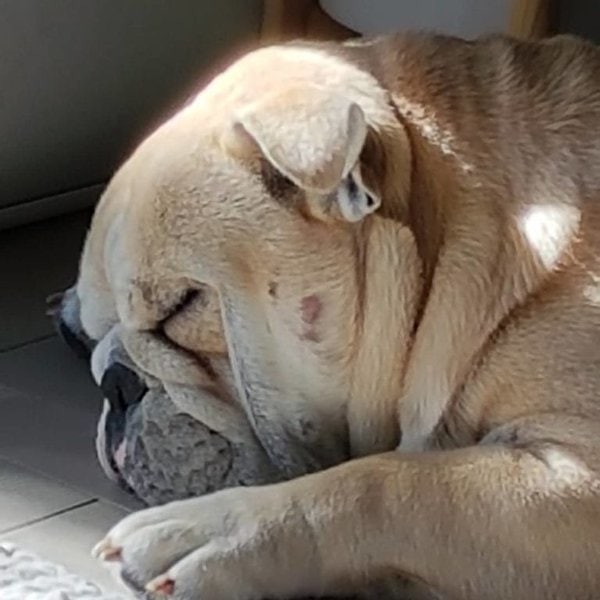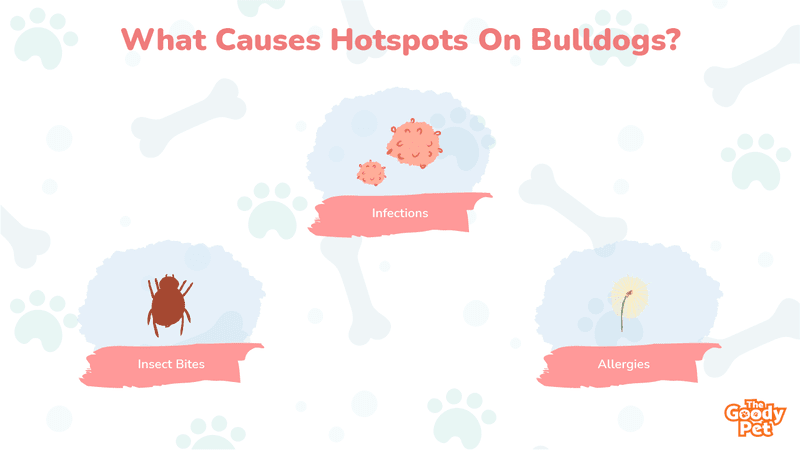Bulldog Hot Spots
It can be a traumatizing experience, as a dog owner, to watch your Bulldog suffer from painful skin hot spots, and not know what to do about it! And it is this experience with Bulldog hot spots that has facilitated this article.
Firstly, what is a Bulldog hot spot? Bulldog hot spots are skin lesions that develop as red and moist swellings on the pooch’s skin. Bulldog hot spots typically occur at a specific location on a Bulldog’s skin, and may develop due to an underlying medical condition, allergies or excessive skin licking by the pooch.
Hotspots are usually very painful for the Bulldog, but the good news is, there are several effective treatment methods and preventive measures available to combat this skin condition, and these are succinctly explained in subsequent sections. However, before we go further, let’s take a more detailed look at the physical appearance of hot spots on Bulldogs and how to tell that a pooch is suffering from this skin condition.
What Is A Hot Spot On A Bulldog?
Bulldog hot spots (also known as acute moist dermatitis) are moist, red patches of irritated skin that are typically localized to a specific area on the dog’s skin.
Hot spots are quite similar in appearance to the reddening and swelling of the skin that is caused by an insect’s bite. But unlike an insect bite, a hot spot typically spreads and worsens over time, if left unchecked.
What Does A Hot Spot Look Like?
A typical hot spot is a red, swollen region of the dog’s skin that is filled with pus and water. The actual size of a Bulldog hot spot may vary greatly, but it usually is big enough to be observed by the naked eye.
During the formation of a hot spot, the affected region begins to ooze pus, which then reacts with the affected skin region to form a tight crust.
Hot spot lesions are usually differentiated from lesions caused by other skin conditions by the fact that the affected area usually retains a moist appearance.
What Are The Signs That A Bulldog Is Suffering From A Hot Spot?
Apart from reddening and irritation of the skin, you can also tell if the swelling on a bulldog is a hot spot by observing signs such as:
- Attempts to lick the swelling
- Foul odor emanating from the swollen region
- Dry, scaly skin around the hot spot
- Increased aggression due to pain caused by the hot spot
- Hair loss
- Sores that ooze pus
What Does A Hot Spot Do To A Bulldog?
Apart from the characteristic physical discomfort that comes with the development of hot spots, these lesions can be quite unpleasant to look at, on your bulldog. And the development of hot spots on Bulldogs can also be associated with hair loss on these pooches.
Additionally, if left untreated, hot spots can spread rapidly and develop into a more serious secondary skin infection.
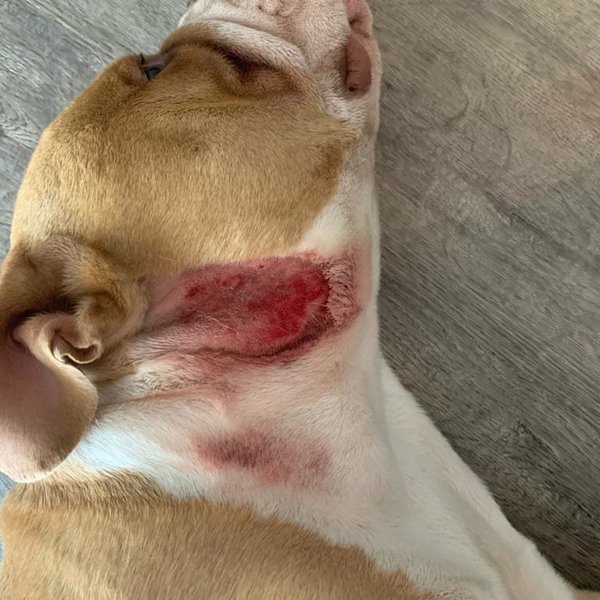
What Causes Hotspots On Bulldogs?
Common causes of Bulldog hot spots include reactions caused by food or flea allergies, stress, infections or boredom.
Allergies
Certain food substances, when consumed by a Bulldog, induce allergic reactions in the pooch. And the itching and scratching that subsequently accompanies this allergic reaction typically results in the reddening and inflammation of the skin.
Apart from reaction to food substances, flea allergy dermatitis may also be responsible for the formation of hot spots on a Bulldog. Flea allergies aren’t necessarily triggered by a massive flea infestation, and a single flea bite is all it takes to induce severe itching and the development of hot spots on a Bulldog.
In the same vein, Bulldogs, like all other pooches can be allergic to pollen. And when pollen falls on, and is absorbed into the Bulldog’s skin, the pooch may lick, bite and scratch to soothe itself, thereby resulting in hot spot formation.
Stress
Excessive licking and chewing of skin is a common sign of stress in Bulldogs. And if the stressor isn’t removed, licking becomes an addiction for the Bulldog, and this in turn, makes the dog’s skin red and swollen.
Infections
Skin or ear infections in Bulldogs usually result in the formation of open sores and wounds, and this usually leads to hot spots forming on the Bulldog’s skin or ear regions.
In the same vein, hot spot formation in a Bulldog’s anal region can be due to an anal sac disease. And in the event of the hot spot bursting, the infection will spread rapidly and cause severe, often irreversible, damage to the anus and rectum.
Insect Bites
When Bulldogs are bitten by poisonous insects, the affected region tends to become reddened and inflamed. And a Bulldog, in a bid to relieve the pain that typically accompanies such bites, may lick the affected regions, thereby expanding the injury and causing the formation of a hot spot.
Boredom
A Bulldog that isn’t getting enough attention and mental stimulation in the form of exercises and play time is likely to develop destructive tendencies.
And in this case, the excessive skin licking and chewing that typically comes with a Bulldog not getting enough physical activity may result in the formation of skin hot spots.
Will A Hot Spot Heal On Its Own?
A hot spot will not heal without the required medical attention and care, and will instead worsen and spread, till it becomes significantly worse.
The good news is, hot spots can be easily treated, and by administering the appropriate medication, you can combat hot spot development on a Bulldog, and regain normal and healthy hair growth on the pooch.
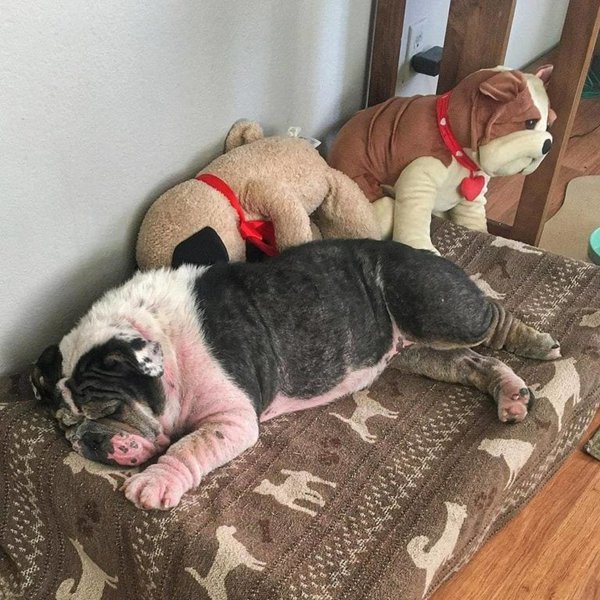
How Do You Treat A Hot Spot On A Bulldog?
Treatment methods typically employed in treating Bulldog hot spots include the use of antibiotics, antiseptics and antihistamines. Natural remedies such as coconut oil, apple cider vinegar and oatmeal are also effective at treating a hot spot on a bulldog.
Once you notice the formation of a hot spot on your Bulldog’s skin, it is important to take such a pooch to the vet’s clinic for prompt medical attention, to prevent the hot spot from spreading further.
Upon arriving at the veterinary clinic, a vet will typically carry out a full physical examination and run a series of tests to determine the underlying cause of hot spot formation on your Bulldog’s skin. And it is the results of the tests and examination that will guide a vet to prescribe treatment for your pooch.
That said, common hot spot treatments prescribed by vets include:
Antibiotics
Your vet may prescribe the use of triple antibiotic ointments to clean and protect hot spot injuries. Oral or topical antibiotics can also be recommended to treat secondary bacterial infections.
Antiseptics
Antiseptics such as Betadine or Chlorhexidine may also be recommended to clean and treat hot spots in dogs, and these are typically diluted before use.
As an alternative to antiseptics, medicated wipes can also be used to clean the hot spot area on a daily basis.
We recommend Glandex Dog Wipes For Pets and its moisturizing properties for this purpose. Glandex Wipes also come with Deoplex, a natural enzymatic deodorizer, to remove any odd smell possibly caused by hot spots and to keep your Bulldog smelling fresh every day.
Antihistamines
Popular antihistamine, like Benadryl, can also be used to soothe and treat skin inflammations caused by hot spots on Bulldogs.
Dietary Supplements
A vet may also prescribe the use of dietary supplements for Bulldogs that have a history of suffering from different skin conditions.
Home Remedies For Treating Hot Spots On Bulldogs
If, for one reason or the other, you’re unable to get immediate access to a vet, there are several home remedies you can employ to control hot spot formation on your bulldog. And some of these home remedies include:
Trimming The Hair Around The Hot Spot
By trimming the area surrounding the hot spot, you’re preventing hair from entering the wound, and possibly worsening the injury. Trimming and clipping the hair around a hot spot also makes the other treatment methods work well without interference and facilitates faster recovery.
Coconut Oil
Coconut oil has special anti-fungal, anti-bacterial, and anti-inflammatory properties and it can be quite effective at bringing instant relief to a Bulldog suffering from hot spots.
Apart from the instant relief it brings, coconut oil also helps speed up the hot spot healing process. And you can apply coconut oil on a bulldog by rubbing a sizable amount on the affected area.
Apple Cider Vinegar
The acidic properties of apple cider vinegar create an acidic environment that bacteria cannot thrive in, and it is another effective means of treating your Bulldog’s hot spot at home.
However, before treating your Bulldog’s hot spot with apple cider vinegar, it is recommended that you dilute it with equal parts water and you should apply the resulting mixture in small amounts.
Oatmeal
Oatmeal is effective at soothing irritated skin, and its anti-inflammatory properties, combined with natural cleansing properties come in handy in treating hot spots on Bulldogs.
To treat your Bulldog’s hot spot with oatmeal:
- Fill a tub with warm water, and mix in two cups of finely ground oatmeal.
- Allow your Bulldog soak in this mixture for ten minutes, while slowly massaging the mixture into its skin.
- Afterwards, rinse the pooch with warm water, and gently dry its skin with a clean towel.
Use Protective Equipment
To prevent your Bulldog from licking and chewing the hot spot, thereby delaying the healing process, it is recommended that you use protective equipment such as an Elizabethan collar.
NOTE: Aloe Vera can also be used to treat Bulldog hot spots; However, Aloe Vera can be toxic when ingested by a pooch and you should only consider this method as a last resort.
What You Should Avoid When Treating Bulldog Hot Spots
You shouldn’t apply human medication, such as Neosporin and Hydrocortisone, on your Bulldog’s hot spot.
Hydrogen peroxide, Listerine and baby powder damage a pooch’s skin and slow down the hot spot healing process; Hence, you shouldn’t apply these on a Bulldog’s hot spot.
How Long Before A Hot Spot Heals?
Hot spots heal relatively quickly, and with prompt and appropriate medical attention, your Bulldog will begin to recover after two to three days of treatment.
However, healing may not be apparent till after one to two weeks of regular treatment. And your Bulldog’s hair may not regrow till after three to four weeks.
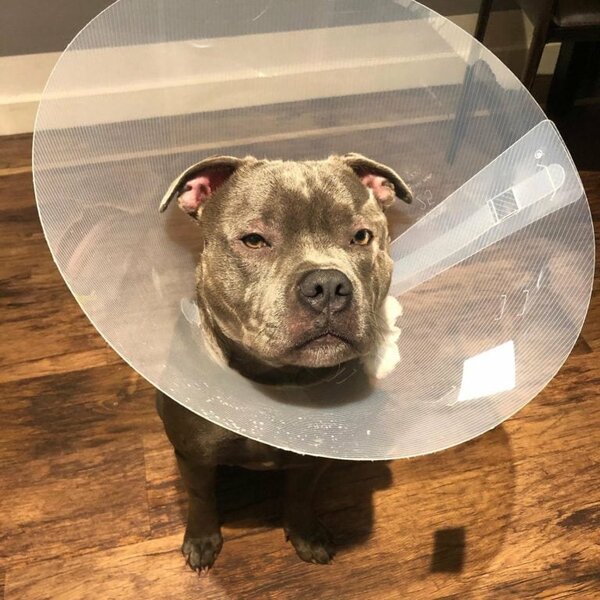
Are Hot Spots On Dogs Contagious?
No, hot spots on dogs are not usually contagious.
A typical Bulldog hot spot is mostly caused by the disruption of bacteria commonly found on the pooch’s skin, either by licking or scratching. And it is this scratching and licking that facilitates the overgrowth of such bacteria, thereby resulting in hot spots.
How To Prevent Hot Spots On Bulldogs?
You can prevent your bulldog from getting by identifying and eliminating allergy triggers, employing stress alleviating methods, treating the underlying medical condition and maintaining great hygiene.
Eliminating Allergy Triggers
As stated earlier, Bulldogs can develop hot spots due to an allergic reaction to a particular food substance; Hence, to prevent the breakout of these painful lesions on your pooch, you should familiarize yourself with the food substances that your furry friend is allergic to.
Understandably, it may take some time to determine the exact food substances that trigger allergic reactions in your bulldog. But by adopting an elimination diet with your vet’s assistance, running blood tests or by paying close attention to your dog’s feeding habits, you can make a significant breakthrough in reducing food allergies in your pooch.
Ensure Your Bulldog Isn’t Stressed
You can also prevent addictive skin licking and chewing in your Bulldog by trying as much as possible to ensure that the pooch doesn’t have to constantly deal with stressful situations.
Avoid staying away from your bulldog for too long, and it can also help to provide a safe, quiet space in the home for your pooch to escape all the hustle and bustle. Additionally, regularly engaging your bulldog in physical exercises and activities can be a great way to help the pooch release tension.
Treat The Underlying Medical Condition
Sometimes, hot spot lesions develop on a Bulldog’s skin as an indicator of an underlying medical condition. Therefore, to prevent further development of these hot spots, you should monitor your pooch for early signs of medical conditions, so that you can administer the appropriate treatment and corrective measures.
Maintain Great Hygiene
Dirt build-up on a Bulldog’s skin usually results in the development of hot spots; Hence, to prevent this from happening, you should make it a routine to groom your pooch’s skin by brushing and bathing. And anytime you bathe your Bulldog, you should make sure to thoroughly dry its coat afterwards.
Additionally, by regularly grooming your Bulldog, you’ll be dealing with the different stages of flea growth and development on the doggie’s skin, thereby reducing the occurrences of flea allergies.
